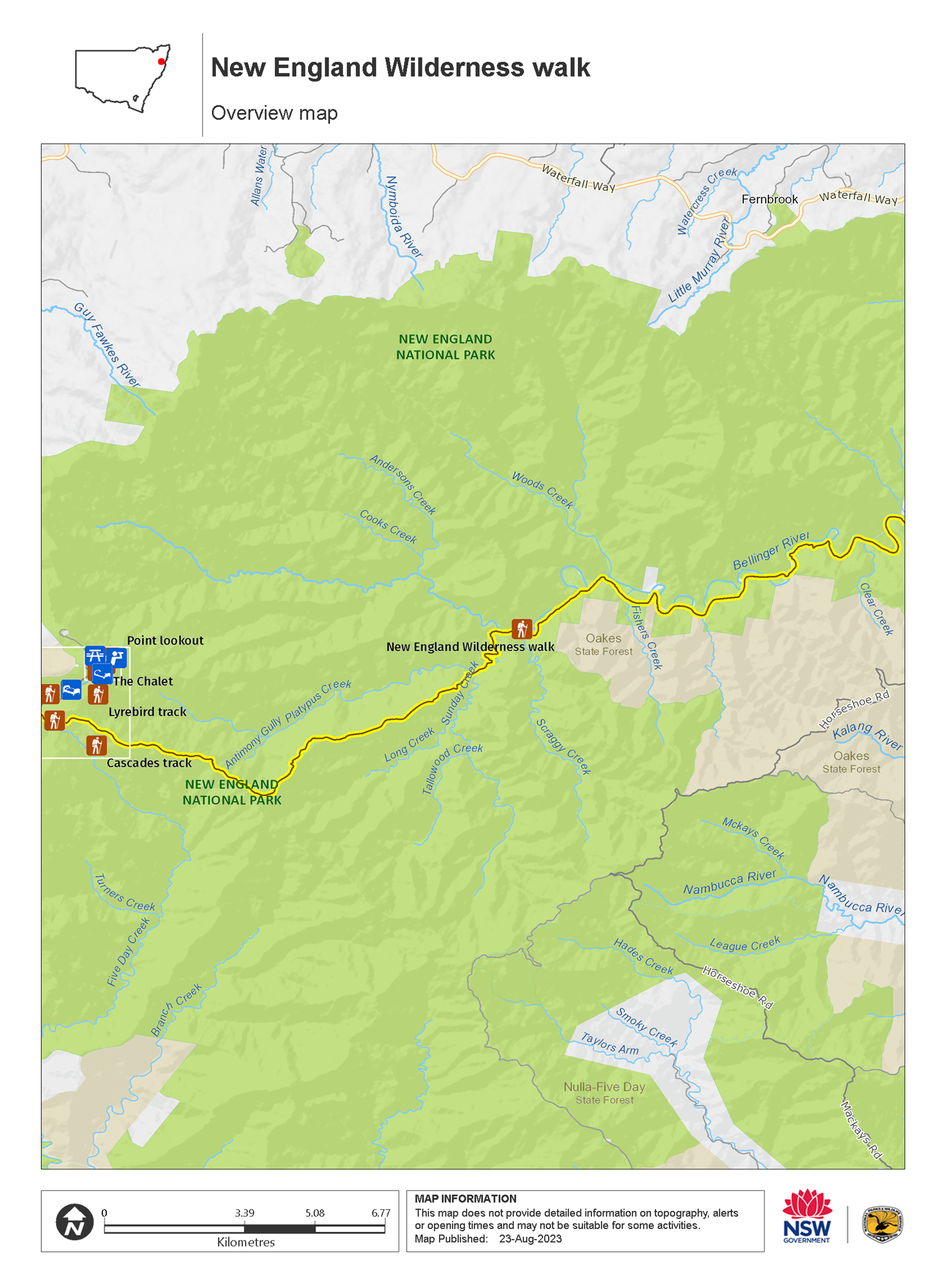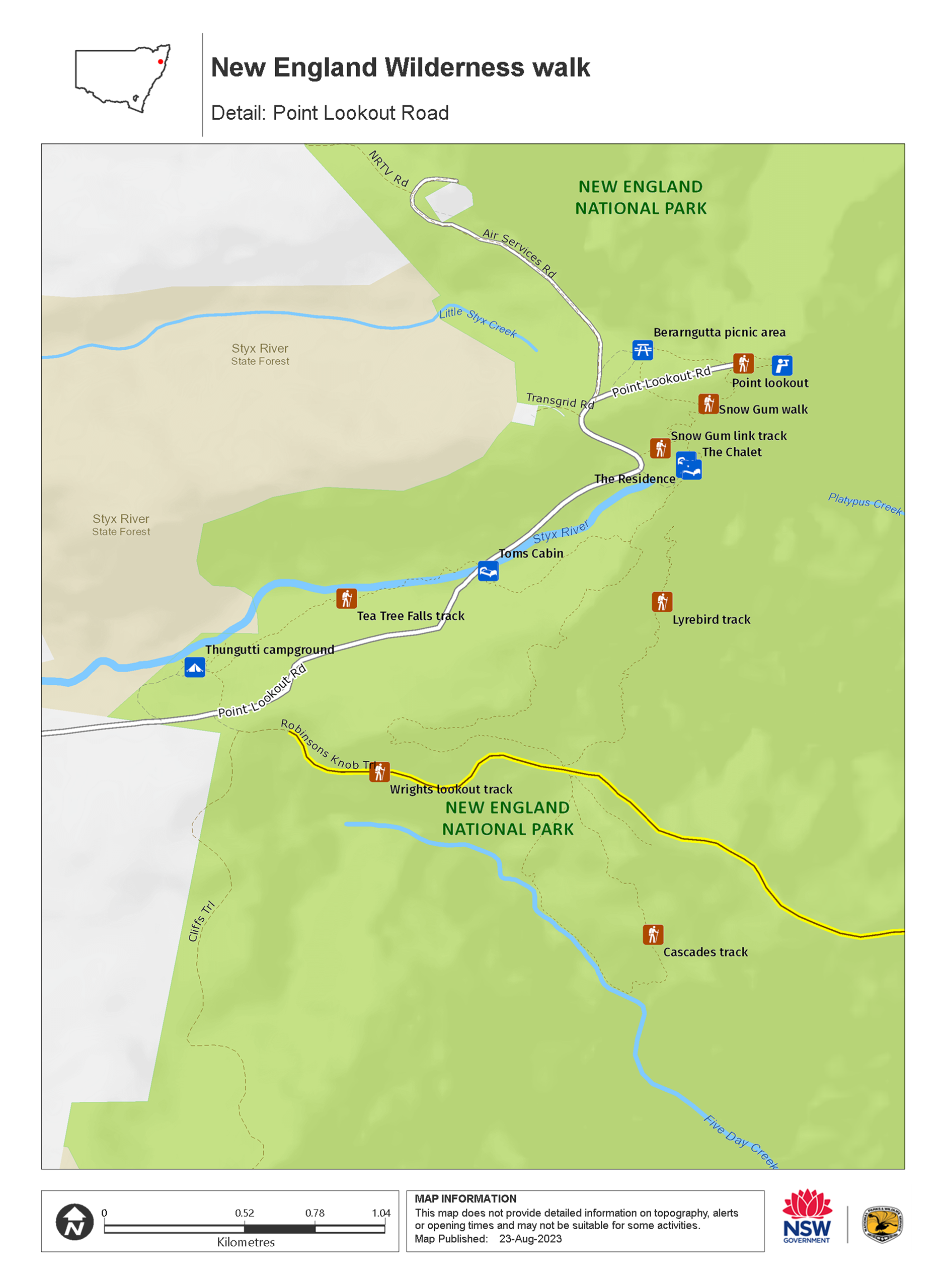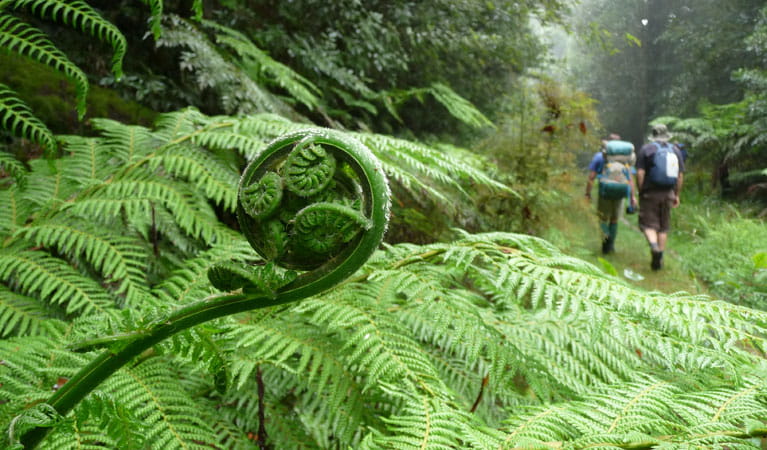New England Wilderness walk
North Coast, Country NSW
Overview
This challenging walk takes experienced bushwalkers on a journey through diverse wilderness, from the edge of New England Tableland to the headwaters of Bellinger River.
- Distance
- 33km one-way
- Time suggested
- 2 - 3 days
- Grade
- Grade 5
- Trip Intention Form
-
It's a good idea to let someone know where you're going. Fill in a trip intention form to send important details about your trip to your emergency contact.
- Personal Locator Beacon
-
Hire a Personal Locator Beacon (PLB) for free at Dorrigo Rainforest Centre.
- What to
bring - Clothes for all weather conditions, drinking water, sturdy shoes, sunscreen, hat
- Please note
- Avoid doing the walk during periods of heavy rainfall and high river levels.
- This park is in a remote location and weather can be unpredictable. Please come well-prepared and tell a family member or friend about your travel plans.
Descending over 1,000m from the edge of New England Tableland to the headwaters of Bellinger River, this multi-day walk invites experienced bush walkers on a journey through diverse wilderness.
Best done over three days, this challenging walk follows the trail up to Wrights lookout. Enjoy the spectacular views before continuing along Snowy Range, then down to Sunday Creek.
The next stage involves creek-walking and river crossings, so make sure you’re equipped with the right footwear. There are lots of opportunities for swimming and serene camping along the way.
Once you reach the valley floor, you’ll wander along an old farm trail over grassy river flats, passing historic farmhouses and stockyards to remind you of the farming heritage here.
The 33km walk finishes on Darkwood Road, but you can also extend your adventure by canoeing or kayaking down the river from Cool Creek Crossing.
Map

Map

Map legend

Local alerts
For the latest updates on fires, closures and other alerts in this area, see https://www.nationalparks.nsw.gov.au/things-to-do/walking-tracks/new-england-wilderness-walk/local-alerts
General enquiries
- National Parks Contact Centre
- 7am to 7pm daily
- 1300 072 757 (13000 PARKS) for the cost of a local call within Australia excluding mobiles
- parks.info@environment.nsw.gov.au
Park info
- in New England National Park in the North Coast and Country NSW regions
New England National Park is always open but may have to close at times due to poor weather or fire danger.
- in Baalijin Nature Reserve in the North Coast region
Visitor info
All the practical information you need to know about New England Wilderness walk.
Maps and downloads
Learn more
New England Wilderness walk is in New England National Park. Here are just some of the reasons why this park is special:
Aboriginal cultural heritage

The park straddles the traditional boundaries of the Dunghutti, Anaiwan and Gumbaynggirr People, and covers an area of great spiritual and cultural significance to local Aboriginals. Point Lookout in particular is a sacred location, known to Aboriginal people as 'Berarngutta', which roughly translates as 'prohibited area'. It is considered a men-only place, and today many Aboriginal women choose to continue this tradition and avoid visiting the area.
- Point lookout Point lookout is a must-see destination for visitors to New England National Park, offering panoramic views across World Heritage rainforest to the ocean in the distance.
Amazing wildlife

The park's altitudinal range, from 150m above sea level to 1563m, makes it a superb habitat for a diversity of wildlife. You might see kangaroos, wallabies, gliders, possums and the inquisitive spotted-tailed quoll. Adults and children alike will love watching the resident lyrebird at Banksia Point. Yet with over 100 species of birds in the park, there are plenty of opportunities for birdwatching. You might spot white-throated tree creepers and rufous fantails in the open forests, while in winter flowering banksias attract Lewins honeyeaters and eastern spinebills.
- Point lookout walking track It only takes 20 minutes to negotiate the easy Point lookout walking track, but the views from this sealed track, within New England National Park, are truly stunning.
- Wrights lookout walking track Wrights lookout walking track takes you through a lush world of ferns and wildflowers to a rocky plateau with spectacular panoramic views looking down to Bellinger River.
Historic heritage

In 2010, New England National Park celebrated its 75th anniversary as one of NSW's most iconic parks. Its history is a testament to the vision and dedication of several influential New Englanders, notably Philip A Wright and his son Peter. They were deeply impressed by the beauty and grandeur of Point Lookout and recognised the value of the area as a sanctuary for plants and animals. After you see the spectacular views at Point Lookout, take a moment to learn about the history of the park and the visionary people behind its conservation.
Volcanic landscape

The steep cliffs of the plateau edge at New England National Park are the result of at least 5 basalt lava flows from the Ebor volcano, forming a rim over 300m thick. Active until about 18 million years ago, this massive volcano was centred around The Crescent, a semi-circular ridge in the Bellinger Valley, visible from Point Lookout. Subsequent erosion has created the dramatic profile of the escarpment we see today. The Banksia Point circuit provides a close-up view of a basalt flow, and you can see the layers of cliffs north from Point lookout.
- Point lookout Point lookout is a must-see destination for visitors to New England National Park, offering panoramic views across World Heritage rainforest to the ocean in the distance.
- Tea Tree Falls walking track Roam through eucalypt forest and beneath hanging moss on Tea Tree Falls walking track, linking Thungutti campground and Toms Cabin in New England National Park.
World Heritage rainforests

The rainforests in New England National Park are part of the Gondwana Rainforests of Australia World Heritage Area; the most extensive strip of diverse rainforest anywhere on earth. The World Heritage Area is a direct window into the past and the future, providing a link to the ancient pre-human world and a stunning and irreplaceable record of life on our planet. Discover the ancient Antarctic beech forests below the escarpment edge on trails like Lyrebird walking track.
- Snow Gum walk Snow Gum walk in New England National Park offers a scenic stroll through World Heritage rainforest. Just 1km and suitable for all ages, it’s ideal as a quick family outing.
Plants and animals protected in this park
Animals
-

Superb lyrebird (Menura novaehollandiae)
With a complex mimicking call and an elaborate courtship dance to match, the superb lyrebird is one of the most spectacular Australian animals. A bird watching must-see, the superb lyrebird can be found in rainforests and wet woodlands across eastern NSW and Victoria.
-

Satin bowerbird (Ptilonorhynchus violaceus)
With vibrant blue-violet eyes and curious antics, the satin bowerbird is a favourite for bird watching and easy to spot as it forages for food in open forest. Relatively common across eastern Australia, in NSW they’re found in coastal rainforests and adjacent woodlands and mountain ranges.
-

Rufous scrub-bird (Atrichornis rufescens)
The vulnerable rufous scrub-bird is a small, ground-foraging bird that lives only in isolated rainforest areas of south-eastern Australia.
-

Spotted-tailed quoll (Dasyurus maculatus)
The spotted-tailed quoll is the largest remaining carnivorous marsupial on the Australian mainland. It’s protected as a vulnerable species in NSW.
Plants
-

Blueberry ash (Elaeocarpus reticulatus)
The blueberry ash is a rainforest shrub which produces blue olive-shaped berries and spectacular bell-shaped flowers, which often appear on the plant together. It is a tall slender shrub or small tree found in rainforest, tall eucalypt forest and coastal bushland in eastern NSW, south-east Queensland and Victoria.
-

Wonga wonga vine (Pandorea pandorana)
The wonga wonga vine is a widespread vigorous climber usually found along eastern Australia. A variation of the plant occurs in the central desert, where it resembles a sprawling shrub. One of the more common Australian native plants, the wonga wonga vine produces bell-shaped white or yellow flowers in the spring, followed by a large oblong-shaped seed pod.
-

Coachwood (Ceratopetalum apetalum)
Coachwood trees are Australian native plants that grow in warm temperate rainforests along coastal NSW. Also known as scented satinwood, the mottled grey bark of the coachwood has horizontal markings and a delicate fragrance.

